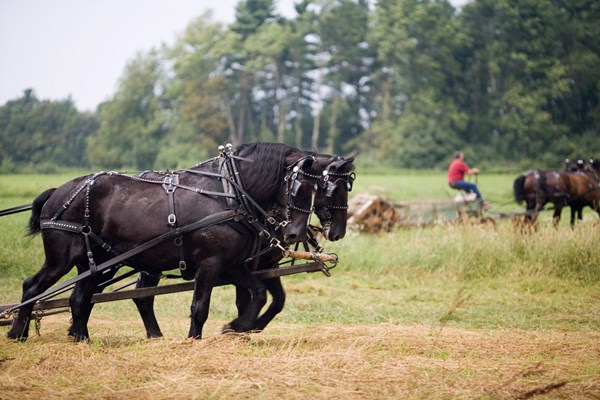 Credit: Thinkstock University of Minnesota researchers have learned new information about shivers, which affects the draft horse breeds, but it also occurs in warmbloods and Thoroughbreds.
Credit: Thinkstock University of Minnesota researchers have learned new information about shivers, which affects the draft horse breeds, but it also occurs in warmbloods and Thoroughbreds.Shivers (also called “shivering”) is a chronic hind limb movement disorder that has been reported to affect horses for over a century. The term “shivers” comes from the trembling of muscles that occurs when affected horses back up or lift a hind limb for the farrier. Shivers was reported to be “as common as dirt” when horses were the only means of transportation, and at the turn of the 20th century, draft breed associations suspected shivers was inherited and advised against breeding affected horses. The syndrome principally affects the draft horse breeds, but it also occurs in warmbloods and Thoroughbreds. Although it has been around for hundreds of years, the disease is not well defined; its basis is unknown and there are no reported successful treatments.
With that vexing background, a team of researchers at the University of Minnesota started working on shivers in earnest about six years ago. The first step was to figure out how to get as much information as possible on a relatively rare disease. The research team, led by Dr. Stephanie Valberg, developed a website on shivers, where owners could upload videos and get answers to questions about the disease. Dr. Alex Draper took on the task of reviewing videos and surveys and finding commonalities as part of her Master of Science thesis. Her results showed that there are several movement disorders in horses besides shivers.
The definition of shivers that arose from her work was difficulty lifting up the hind limbs for a handler, combined with difficulty walking backward. Shivers horses hyper-flexed one or both hind limbs when backing up or, in some cases, horses suddenly extended their legs straight behind them when backing up. Although they had great difficulty walking backward, most horses with shivers walked forward with ease. Most had competed successfully, but a small number became so severely affected that they could no longer compete at the same level, and their hooves could not be trimmed by a farrier. In advanced cases, shivers was also apparent at a walk, and horses would intermittently hyper-flex a hind limb when turning sharply or changing direction.
It was clear from the research that sex and height were important factors. Shivers was most common in horses 16.3 hands or taller and much more common in geldings than mares. Signs of shivers usually began by 7 years of age and, in at least half of shivers horses, owners reported a gradual worsening of signs over time. Owners did not consistently report any therapeutic, dietary, or management changes that resolved signs completely. Providing regular exercise and turnout, increasing forage and fat, and supplementing vitamin E were reported by owners to reduce the severity of signs in some horses.
Research into shivers continues at the Leatherdale Equine Center and is currently focused on finding the basis for the disease. A thorough evaluation of the nervous and muscular system of horses with shivers has been conducted with neuropathologists and neuroscientists at the University of Minnesota’s Human Sensorimotor Control Lab, who glued skin electrodes over muscles of the hind limb to monitor the pattern of recruitment of muscles during locomotion.
The results are fascinating. In shivers horses, the smooth control over the pattern of contraction of flexor and extensor muscles in the hind limb is disrupted, leading to muscles misfiring and the limb becoming stuck and trembling. Dr. Anibal Armein, a neuropathologist at the College of Veterinary Medicine, has found a small area of degeneration in shivers horses in a region of the brain that regulates locomotor patterns. While the hunt for the cause of shivers continues, knowing what part of the brain is affected and how it impacts locomotion is a huge leap forward.
“Research into a disease is much like slowly putting pieces of a puzzle together,” Valberg says. “You need the framework before the picture starts to come to light. We are getting closer and closer to understanding how the shivers pieces fit together. We are so grateful to all the owners who contributed to the study. I know it seems to take a long time to get results, but science is about testing and retesting to make sure your results are accurate. It is accurate results that help horses and horse owners.”
To learn more about shivers visit the University of Minnesota Equine Center website.


